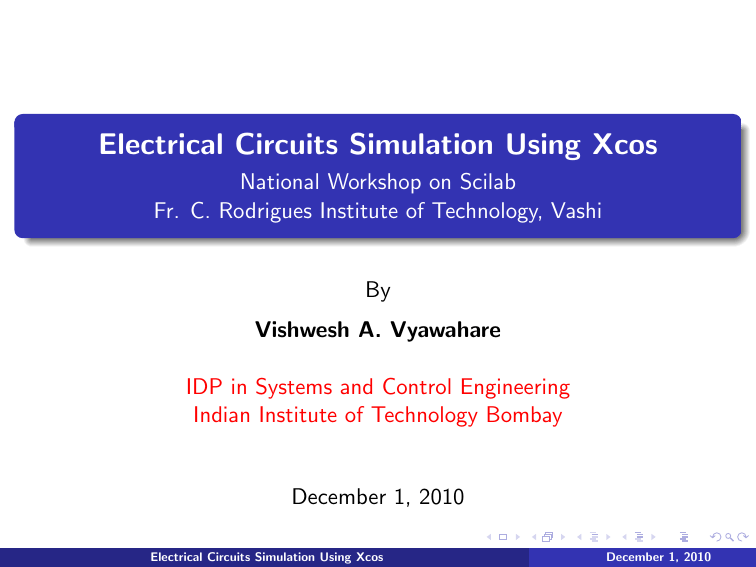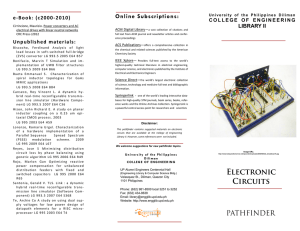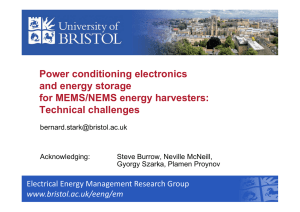Electrical Circuits Simulation Using Xcos
advertisement

Electrical Circuits Simulation Using Xcos National Workshop on Scilab Fr. C. Rodrigues Institute of Technology, Vashi By Vishwesh A. Vyawahare IDP in Systems and Control Engineering Indian Institute of Technology Bombay December 1, 2010 Electrical Circuits Simulation Using Xcos December 1, 2010 Outline DC source with R without switch. Switch logic in Scilab DC source with R, RL, RC, and RLC, with switch. AC source with RLC with switch. Demos of some more complicated ckts. Electrical Circuits Simulation Using Xcos December 1, 2010 DC source with R We have i(t) = V . R + vR(t) R V i(t) Electrical Circuits Simulation Using Xcos December 1, 2010 Switch Logic in Scilab Opening or closing of switch is an important operation. Useful in Power Electronics ckts. Adding a switch in the ckt makes the ODE stiff for solving. Square wave Electrical Circuits Simulation Using Xcos December 1, 2010 DC source with R with Switch Memory-less system. Current and voltage change instantaneously after the closing of switch at t = 0. t=0 V Electrical Circuits Simulation Using Xcos R i(t) December 1, 2010 DC source with RL with Switch Current through the inductor cannot change instantaneously. At t(0+), inductor → Open Circuit ⇒ iL (0+) = i(0+) = 0. vL (0+) = V . For general t > 0, di(t) . V = Ri(t) + L dt t=0 t=0+ L R R V V vL(0+) = V + OC i(0+)=0 i(t) vL(t) t>0 L R t inf R vL(inf)=0 SC V i(t) Electrical Circuits Simulation Using Xcos V i(inf) December 1, 2010 DC source with RL with Switch Expression for current is i(t) = V V R − e− L t . R R Expression for inductor voltage is R v (t) = Ve − L t . At steady-state (t → ∞), inductor acts as a short-circuit, vL (∞) = 0 and i(∞) = VR . Electrical Circuits Simulation Using Xcos December 1, 2010 DC source with RC with Switch Voltage across the capacitor cannot change instantaneously. At t(0+), capacitor → Short Circuit ⇒ vC (0+) = 0. iC (0+) = i(0+) = VR . For general t > 0, Z 1 t i(t)dt. V = Ri(t) + C 0 t=0 V i(t) t>0 V t=0+ R Vc(t) + - C V i(t) i(0+) t R Vc(t) + - C V Electrical Circuits Simulation Using Xcos R inf SC Vc(0+)=0 OC Vc(inf)=V R i(inf)=0 December 1, 2010 DC source with RC with Switch Expression for capacitor voltage is t vC (t) = V − Ve − RC . Expression for capacitor current is i(t) = V −t e RC . R At steady-state (t → ∞), capacitor acts as a open-circuit, vC (∞) = V and i(∞) = 0. Electrical Circuits Simulation Using Xcos December 1, 2010 DC source with RLC with Switch Two storing elements. Second-order system. Square wave -1 MScop Electrical Circuits Simulation Using Xcos December 1, 2010 DC source with RLC with Switch KVL gives di(t) 1 V = Ri(t) + L + dt C Z t i(t)dt. 0 The second-order ODE is d 2 i(t) R di(t) 1 + i(t) = 0. + 2 dt L dt LC At t(0+), i(0+) = 0, di dt (0+) = V L Electrical Circuits Simulation Using Xcos = vL (0+) L . December 1, 2010 DC source with RLC with Switch Using Laplace transform I (s) = V /L2 s 2 + RL s + 1 LC As t → ∞, current i(t) will decay to zero. But the way it will decay to zero will be decided by the value of R. Equating the denominator polynomial to zero, s2 + R 1 s+ =0 L LC The roots are −R/L ± s1,2 = Electrical Circuits Simulation Using Xcos q R2 L2 − 4 LC 2 December 1, 2010 DC source with RLC with Switch The transient behaviour of i(t) will be decided by the factor D+ 4 R2 − (<, >, =)0. 2 L LC If D = 0 then r R=2 L . C Response is overdamped. If r R<2 L . C Response is underdamped. Electrical Circuits Simulation Using Xcos December 1, 2010 AC source with RLC with Switch Sinusoidal source connected to a series RLC ckt through the switch. Second-order system. Square wave -1 220 ~ MScop Electrical Circuits Simulation Using Xcos December 1, 2010 Complicated Networks Examples taken from the book: Network Analysis, by M.E. Van Valkenburg, PHI Publishers, New Delhi, 2006. Ex. 5-6, Page 132. Steady-state is reached with switch closed. At t = 0, the switch is opened. Find voltage across the switch and the value of its first time derivative at t = 0+. Square wave MScop Electrical Circuits Simulation Using Xcos December 1, 2010 Complicated Networks Ex. 4-1, Page 112. Steady-state is reached with switch in position 1. At t = 0, the switch moved from 1 to 2. Find i(t). Square wave -1 ... MScop Electrical Circuits Simulation Using Xcos December 1, 2010

